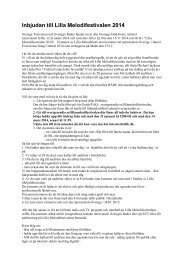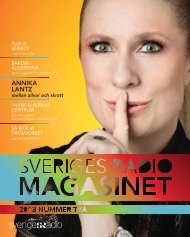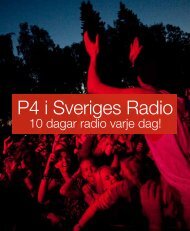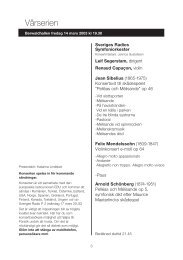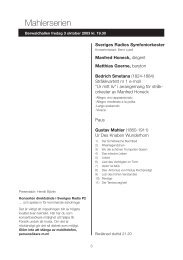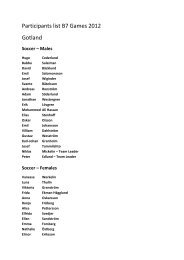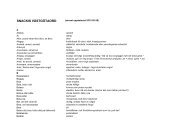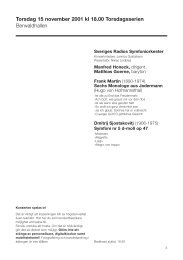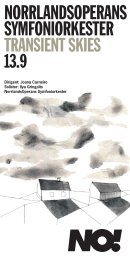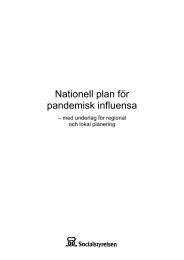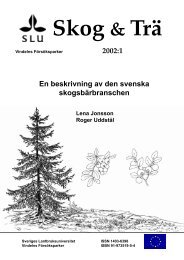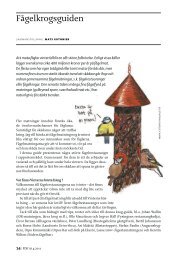SEMF 2013 Festivalprogram (pdf) - Sveriges Radio
SEMF 2013 Festivalprogram (pdf) - Sveriges Radio
SEMF 2013 Festivalprogram (pdf) - Sveriges Radio
Create successful ePaper yourself
Turn your PDF publications into a flip-book with our unique Google optimized e-Paper software.
Fredag 7 juni<br />
Friday 7 June<br />
Lördag 8 juni<br />
Saturday 8 June<br />
Söndag 9 juni<br />
Sunday 9 June<br />
Framför allt är det en resa genom några av de mest inflytelserika<br />
centraleuropeiska musiksamlingarna. Codex Caioni är<br />
förmodligen ett av de viktigaste manuskripten i den ungerska<br />
musikhistorien. Mannen bakom manuskriptet, Johannes Caioni<br />
(1629–1687), var en transylvansk franciskanermunk och romerskkatolsk<br />
präst, musiker, folklorist, humanist, samt orgel byggare<br />
och reparatör. Denna 1600-talssamling inkluderade inte bara<br />
346 tyska, italienska och ungerska vokala och instrumentala<br />
kompositioner, utan även några slovakiska och rumänska folkvisor<br />
och danser. Det spelas även stycken ur den Leutschauerska<br />
tabulaturboken för orgel, troligen sammanställd i norra Ungern<br />
omkring 1660–1670, med danser som re presen terar 1600-talets<br />
mest avancerade instrumentala stil i Ungern och Central europa.<br />
Från samma period kommer Vietoris tabulaturbok, sammanställd<br />
av sex okända upphovsmän.<br />
Runt mitten av 1700-talet utvecklades föregående sekels dans<br />
”ungaresca” till en ny dansmusik känd som ”Verbung” eller<br />
”Verbunkos”. Några stycken ur samlingen ”Nouvelle Collection<br />
d’Hongroises” från 1808 ger exempel på detta. Pro grammet<br />
av slutas med en avdelning danser av typen ”Hajdú” eller<br />
”Heiducken”, uppkallade efter hejdukarna som var krigare och<br />
boskaps fösare.<br />
’Ungaresca’ takes us on a journey through Hungarian and Central<br />
European music, from stately castles to village cottages, from the<br />
second half of the 16th century to the early 19th century. On the<br />
way we encounter French, Italian, and Dutch composers as well as<br />
Hungarian ones – for instance Valentin Bakfark, born in Braşov,<br />
Transylvania, who was also renowned as a lute virtuoso.<br />
Mostly, it is a journey through some of the most influential Central<br />
European collections of music. The Codex Caioni is probably one of<br />
the most important manuscripts in Hungarian music history. The<br />
man behind the manuscript, Johannes Caioni (1629–1687), was<br />
a Transylvanian Franciscan monk and Roman Catholic priest,<br />
musician, folklorist, humanist, constructor and repairer of organs.<br />
This 17th century collection included not only 346 German, Italian,<br />
and Hungarian vocal and instrumental compositions, but also presented<br />
some Slovakian and Romanian folk songs and dances. Pieces<br />
are played, too, from the Leutschauer organ tabulature book, probably<br />
compiled around 1660–1670 and featuring dances representative<br />
of the most advanced instrumental style in Hungary and Eastern<br />
Europe. A great collection of the period is also the Vietoris Book of<br />
Tabulature, compiled by six unknown chroniclers.<br />
Around the middle of the 18th century the ”ungaresca” dance type<br />
of the previous century developed into a new dance music known as<br />
the ”Verbung” or ”Verbunkos”, exemplified in the pieces from the<br />
1808 ”Nouvelle Collection d’Hongroises”. The programme closes<br />
with a set of ”Hajdú” or ”Heiducken” dances, so named after the<br />
Heyducks, who were warriors and cattle drovers.<br />
Robert Mandel, vevlira • renaissance vielle<br />
Gabor Kállay, blockflöjter, rebec och sång •<br />
recorders, rebec and voice<br />
Zsolt Szabó, viola da gamba • viol<br />
Istvan győri, luta och slagverk • lute and percussion<br />
Robert Mandel tog examen i instrumenttillverkning och fick<br />
ett stipendium från German Music Council i syfte att studera<br />
restaurering av instrument i Germanisches Nationalmuseum<br />
i Nürnberg. I den berömda instrumentsamlingen vid Musikkonservatoriet<br />
i Paris undersökte han vevliror från 1700-talet.<br />
Hans huvudsakliga forskningsområden sträcker sig från<br />
23



